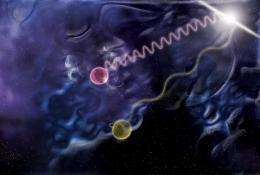January 11, 2012 weblog
Physics team finds new constraints on how lumpy space-time can be

(PhysOrg.com) -- Robert Nemiroff and his colleagues at Michigan Technological University will be discussing new constraints on the so-called lumpiness of space-time at this year’s meeting of the American Astronomical Society.
Nemiroff, also known for his Astronomy Pick of the Day site, has been studying photons that have been traveling through space for several billion years following a γ-ray burst that was recorded back in 1989. Called GRB 090510A, the burst let loose high energy photons that have been traveling through space at the speed of light; two of them are of special interest to physicists because they are believed to have left the same place at exactly the same time, which would seem to make them arrive here at exactly the same time as well. But, they won’t, due to the lumpiness of space-time and the long distance they have traveled.
In the abstract for the presentation, the authors suggest that because a high-energy time scale for the photons detected from the gamma-ray burst have been found, a new upper limit is in place on the dependence of energy on speed and light as it’s dispersed across the universe.
Studies of high energy photons traveling through space have already shown there are differences in actual speeds recorded, though they are very, very small; seven parts in a billion trillion, according to a previous study done by researchers at Yale. Because of this and other studied phenomenon, various researchers have theorized that space-time isn’t actually continues as it appears, but is instead made up of very, very tiny elements that are almost unbelievably small, on the order of a 10-35 (the Planck length). In such theories, photons that have the highest amount of energy also have wavelengths that are near to the Planck length. This makes them more apt to intermingle with so-called “lumps” which slows them down. The amount of slowdown is obviously very tiny, but as the photons travel so far for so long, the effect is amplified.
In their study, Nemiroff et al, find due to measured differences in the arrival time of the two photons, that new constraints are in effect that impact the lump size of space-time. Because of this, the lumpiness of space-time only becomes meaningful when things are roughly 1/500 the Planck length, which could, obviously, put some limits on quantum gravity theories.
More information: Nemiroff, R. J., Connolly, R., & Holmes, J. A New Limit on Lorentz Invariance and Chromatic Dispersion Across the Universe from GRB 090510A (American Astronomical Society, 2011)
Abstract
A high-energy, fast-variability time scale for Fermi-detected gamma-ray burst GRB 090510A is found that creates a new strictest upper limit on the energy dependence of the speed and dispersion of light across the universe. In particular, evidence is presented for variability at or below Δ t = 0.00136 for super-GeV photons, a factor of 10 more limiting than any time scale previously claimed for a GRB at GeV energies, including a previous limit reported by Abdo et al (2008). This variability derives from the duration of three separate closely-arriving photon groups prominent only in photon data above 1 GeV. One pulse pair has an energy difference of Δ E >/~ 23.5 GeV. Coupled with a redshift of z >/~ 0.897, the resulting limits on the differential speed of light and Lorentz invariance were found for a concordance cosmology. It was found that Δ c / c < 6.09 x 10-21, a limit consistent with, but slightly stronger than, a previous limit found for a GRB by Schaefer in 1999. Given a generic dispersion relation across the universe where the time delay is proportional to the photon energy to the first power, the variability translates into a dispersion strength of k1 < 1.38 x 10-5 sec Gpc-1 GeV-1. This limit results in an upper bound on dispersive effects created, for example, by dark energy, dark matter, or the spacetime foam of quantum gravity. This dispersion constraint also results in the most stringent lower limit yet claimed for the onset energy scale of quantum gravity: MQG c2 > 7.43 x 1021 GeV.
via Nature
© 2011 PhysOrg.com




















